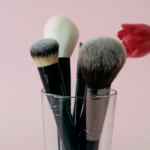Makeup is more than just a beauty routine; it’s an art form, a self-expression, and a way to elevate your style. Whether you’re getting ready for a special occasion or simply want to feel fabulous on an ordinary day, mastering the full makeup look can transform not only your appearance but also your confidence. Picture this: blending vibrant eyeshadows that pop against your skin, sculpting those cheekbones with flawless contours, and finishing it all off with the perfect lip color that ties everything together. It’s like painting on a canvas—each stroke enhances your natural beauty.
In this ultimate guide to fashion makeup, we’ll explore essential products you need in your toolkit and help you discover colors that complement your unique skin tone. You’ll learn step-by-step techniques for achieving stunning looks while keeping them fresh throughout the day. Plus, we’ll share styling tips to ensure every detail of your outfit harmonizes beautifully with your makeup.
Ready to unlock the secrets of full makeup looks? Let’s dive into this transformative journey where glamour meets artistry!
The Power of Makeup: How It Can Transform Your Look
Makeup holds an incredible power to change how we see ourselves. A swipe of mascara can open up tired eyes, while a touch of blush adds life to a dull complexion. It’s about enhancing features and expressing individuality.
With the right products, you can create endless looks that reflect your mood or occasion. Want to feel bold? Go for dramatic eyeliner and vibrant lipstick. Looking for something soft? Opt for natural tones and subtle highlights.
The transformation isn’t just physical; it impacts confidence too. When you look good, you feel empowered. That radiant glow can lift spirits and make any outfit stand out even more.
Moreover, makeup allows experimentation without commitment—try new styles today and wash them away tomorrow! This creative outlet fosters self-discovery as you learn what makes you shine from within.
Essential Products for a Full Makeup Look
To achieve a stunning full makeup look, it’s crucial to have the right products in your arsenal. Start with a high-quality primer that creates a smooth canvas and helps your makeup last longer.
Foundation is next. Choose one that suits your skin type—liquid for dry skin or powder for oily complexions. Don’t forget concealer to cover any blemishes or dark circles.
For eyes, an excellent palette can transform your gaze. Opt for versatile shades that allow you to create both day and night looks effortlessly. A reliable eyeliner and mascara will define those beautiful peepers.
Blush adds life to your cheeks, while bronzer can sculpt and warm up your complexion beautifully. Finish off with a lipstick or lip gloss that complements the entire look. With these essential products, you’re well on your way to mastering fashion makeup like a pro!
Finding the Right Colors and Shades for Your Skin Tone
Choosing the right colors and shades for your skin tone can elevate your makeup game significantly. Understanding whether you have a warm, cool, or neutral undertone is crucial.
If you lean towards warm tones, look for shades with golden hues. Earthy colors like reds, oranges, and browns will complement your complexion beautifully.
Cool-toned individuals should opt for pinks, plums, and blues that highlight their natural glow. Silver jewelry often suits this category best.
Neutral undertones allow a mix of both worlds. You can experiment with various palettes without limitations.
A simple trick? Test foundation on your jawline in natural light to find the perfect match. Swatching lipsticks on your wrist can reveal what looks best against your skin.
Don’t forget about blush! A shade that enhances rather than clashes makes all the difference in achieving that flawless finish.
Step-by-Step Guide to Achieving a Full Makeup Look
Start with a clean canvas. Wash your face and apply moisturizer to hydrate your skin. Allow it to absorb before moving on.
Next, grab your foundation. Choose one that matches your skin tone perfectly. Use a makeup sponge or brush for an even application, blending it into the jawline and neck.
Conceal any blemishes or dark circles using a creamy concealer. Dab gently and blend well for a flawless finish.
Set everything in place with translucent powder to avoid shine throughout the day.
Now, it’s time for eyeshadow! Select colors that complement your style. Start with a neutral base shade before adding depth with darker hues in the crease.
Don’t forget eyeliner and mascara to define those beautiful lashes.
Add some color back into your cheeks with blush, followed by highlighting key areas of your face for that radiant glow.
Finish off with lipstick or gloss in shades you love—your full makeup look is almost there!
Tips and Tricks for Making Your Makeup Last All Day
To keep your makeup looking fresh all day, start with a solid base. A good primer can work wonders by smoothing out imperfections and creating an ideal canvas.
Setting sprays are your best friend. After applying your makeup, mist some setting spray to lock everything in place. This step is often overlooked but makes a significant difference.
Choose long-wear products whenever possible. Foundations, eyeliners, and lip colors designed for longevity will endure the test of time better than traditional formulas.
Blotting papers are essential for combating shine throughout the day without disturbing your look. Simply press them against oily areas instead of adding more powder.
Carry travel-sized essentials in your bag—like lipstick or powder—for quick touch-ups on the go. These little tweaks can help you maintain that flawless finish from morning till night!
Accessorizing and Styling to Enhance Your Full Makeup Look
Accessorizing is key to elevating your full makeup look. The right pieces can complement your style and enhance your overall appearance.
Start with jewelry. Opt for statement earrings or a bold necklace that draws attention without overwhelming your makeup. Gold and silver tones can provide a beautiful contrast against vibrant lip colors.
Consider hair accessories as well. A chic headband or embellished clips can add flair while keeping focus on your flawless face.
Don’t forget about hats; they can introduce an element of sophistication or casual elegance, depending on the occasion.
Choose the perfect handbag to tie everything together. Whether it’s a clutch for nighttime glamour or a structured bag for daytime chic, make sure it reflects your personal style and complements the hues in your makeup palette.
Final Thoughts on Rocking a Full Makeup Look with Confidence
Embracing a full makeup look can be an empowering experience. It’s not just about the products you use; it’s about how you feel when wearing them. Confidence radiates from within, and makeup is simply a tool that enhances your natural beauty.
Experiment with different styles and techniques to discover what makes you feel your best. Remember, there are no strict rules in fashion makeup—only guidelines that help express your individuality. The key is to have fun while exploring various looks and finding what resonates with your personality.
As you master new skills and gain confidence in applying makeup, you’ll notice how it transforms not only your appearance but also how you carry yourself. So go ahead, take the plunge into the world of full glam or soft elegance—whatever speaks to you most.
With each application, you’re not just putting on layers of color; you’re telling the world who you are. Embrace it fully and enjoy every moment spent perfecting those stunning looks!


